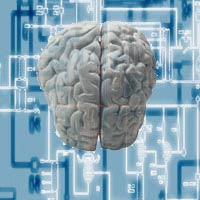The melding of flesh and silicon is taking shape as scientist at the Georgia Inst. of Technology develope a technique to give "life" to "thousands of rat neuron cells."
--BJK

Rat-Brained Robot
By David Cameron December 18, 2002
Rat neuron cells on silicon are the brains behind a new robot—a breakthrough that may lead to better computer chips.
Steve Potter’s brand new robot would probably never make it to the second round of Battlebots. The size of a coffee mug, the cylindrical robot slides across a round meter-sized playpen on an apparently chaotic path. But this robot is a thinker, not a fighter, and it does its thinking with a network of neurons—culled from rat embryos—that resides a few feet away on an electrode-activated silicon chip.
Article














































